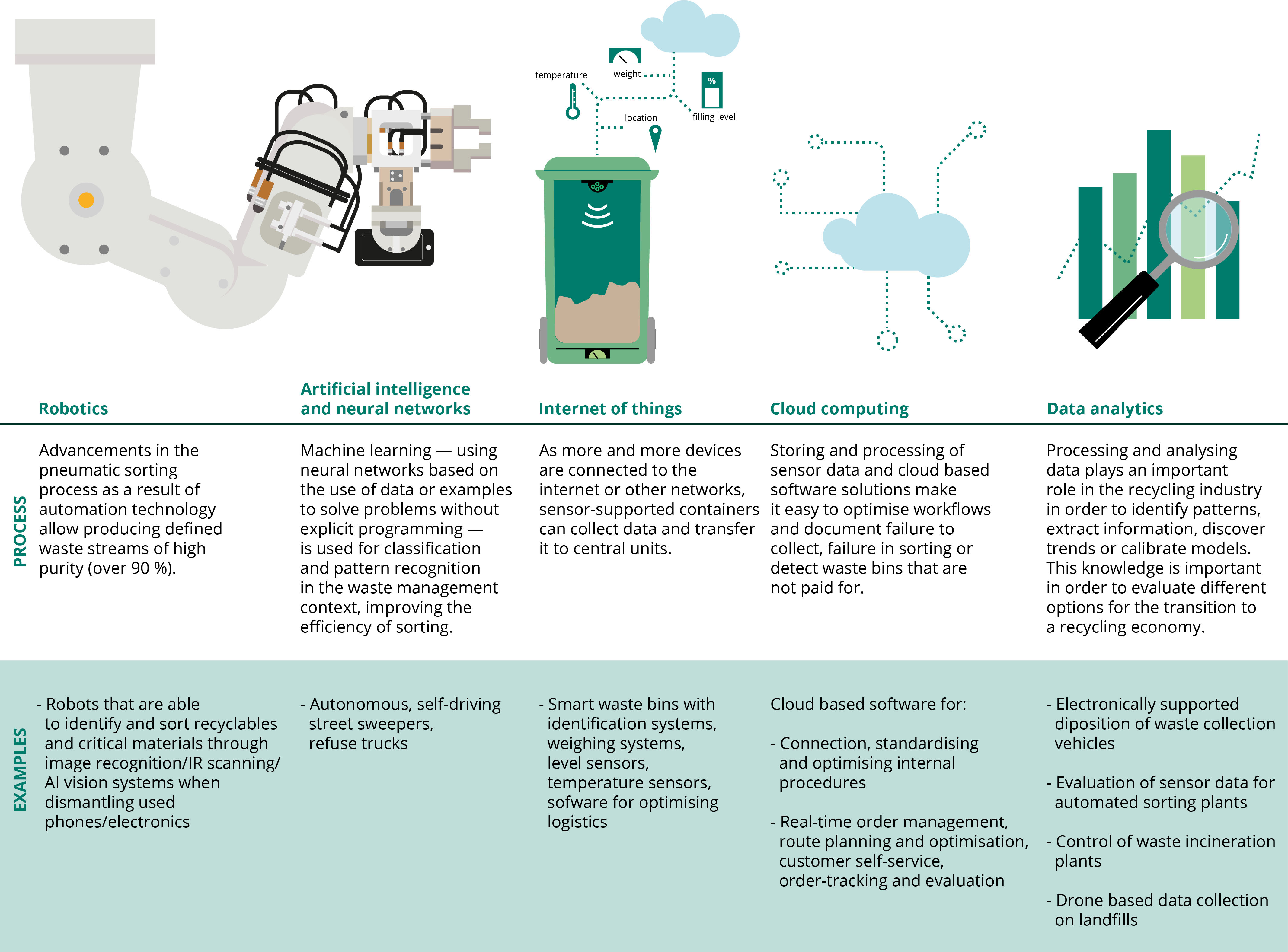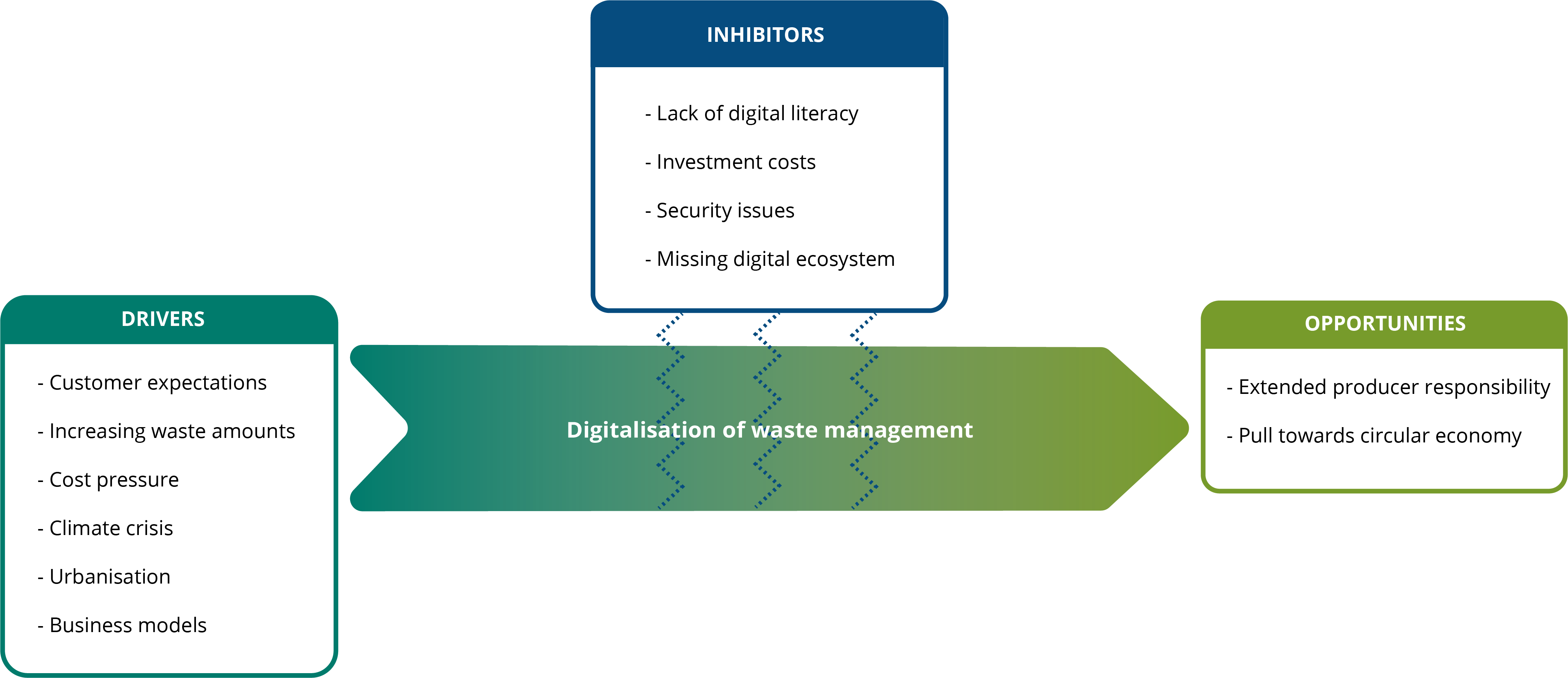This briefing provides an overview of the potential for a digital transformation of the European waste management sector. It is based upon on the underpinning report by the European Topic Centre on Waste and Materials in a Green Economy (ETC/WMGE).
Using digital technologies in waste management
The uptake of digitalisation technologies across society is largely a result of continuing advances in miniaturisation, increased processing power and falling costs. Waste management is no exception, and it is also benefiting from improving digital technologies.
Examples of specific digital technologies that are currently used and expected to have a major impact in future on the efficiency of the waste industry include robotics, the internet of things, cloud computing, artificial intelligence and data analytics (Figure 1).
A revolution in waste management logistics
Digital technologies are increasingly applied across almost all areas of waste collection. Certain aspects of collection have been transformed by advances in digitalisation, especially logistics — the process of organising, scheduling and dispatching tasks, personnel and vehicles. Here, digital tools offer the potential to enhance the process by storing, processing, analysing and optimising the necessary information. Information generated during the collection process, e.g. on task progress or incidents, can be monitored in real time.
As greater volumes of information are collected, so complexity grows. In such instances optimisation algorithms help find the most suitable options for allocating resources such as workforce or vehicles. Important technologies include telematics, including routing systems, navigation and vehicle tracking software, enterprise resource planning (ERP) systems and similar. The resulting improvements are most apparent in increased efficiency. Another example is the so-called internet of things, including applications such as smart bins and robotics for semi-autonomous waste collection vehicles.
There remains substantial room to improve the waste collection process in the future and to align it with the needs of a circular economy. For example, it needs to be able to respond more flexibly to changing waste patterns and targets, or to facilitate the implementation of on-demand and customised services (ISWA, 2019).
Another part of waste collection is the process of documentation, communication and billing. Here, the ongoing switch from paper-based administration systems to digital systems, as seen in other industries, will further increase the efficiency of processes and flow of information. The technologies involved include digital identity tags for waste bins and containers, digital order processing, digital billing and payment, digital user interfaces for communication with consumers, and connecting public waste collection providers with other relevant governmental databases.
If these digital technologies are applied in documentation processes, they can be used to gather waste-related data from the public. Turned into valuable information by data analytics, they can support a circular economy through ‘a better understanding of the spatial and temporal patterns of waste generation’ (ISWA, 2019). In addition, the potential to collect many single data points instead of just reporting cumulative values can give local authorities further insights.
Digitalisation as a means to incentivise green behaviour
Pay-as-you-throw systems become more feasible using digital identification and billing techniques. These systems allow for a ‘fair’ billing scheme by allocating costs proportional to the amount of waste generated. It has been shown, however, that such schemes can have negative effects through attempts to avoid paying, such as increased illegal littering, use of public bins and ‘waste tourism’ to neighbouring regions with traditional billing schemes (Kinnaman, 2009).
Digitalisation also enables the development of advanced ‘know-as-you-throw’ schemes. In these schemes, waste management operators use radio-frequency identification (RFID) to monitor waste fractions at household level. A chip follows the waste and, once the operator has determined the quantity and quality of separation, this information is automatically fed back to the individual or company who generated the waste. Providing tailored messaging — e.g. appreciation for waste savings or good separation behaviour — can help nudge consumers towards better waste management practices, intersecting with waste prevention programmes.
Reducing costs and reaping the opportunities of automation
Waste management operations are a complicated logistical challenge involving substantial manual handling and, hence, labour costs. Digitalisation offers opportunities to reduce these costs and create better employment opportunities in higher value parts of the business chain.
One important field of application is the sorting process, which is a prerequisite for high-level recycling. AI image processing techniques supported by robotic sorters are developing fast and are already used by several global manufacturers of commodities such as electronics. Other approaches include the labelling of products using watermarks, quick-response (QR) codes or other kinds of digitally readable markers. These can support automated sorters by feeding them information on the material composition and product set-up, facilitating the recovery of high-value materials.
Robotic sorters can also generate information on the sorted materials, further optimising the subsequent processes or improving the AI. An example is the use of these data streams to predict patterns in incoming loads of waste and to learn about the waste sorting efficiency to predict the set-up of sorting lines. If these data are linked to other relevant data, such as prices in secondary raw material markets, then processes can also be adjusted accordingly.
Drivers and inhibitors
The waste management sector operates with low margins, is highly competitive, and continuously under pressure to reduce costs. Digital technologies require investment, but they also offer scalable efficiencies.
The report on digitalisation by the European Topic Centre provides further details of the main drivers and inhibitors of the digitalisation process. It identifies a number of economic, societal and technological barriers (Figure 2).
Environmental trade-offs created by increasing digitalisation for waste management
Greater digitalisation can help achieve circular economy goals across the waste management cycle, from the material sourcing, production and use phases through to the reuse of resources. However, the digital transformation of Europe’s waste management infrastructure may create several generic trade-offs (Figure 2). The first is energy use. Supporting digital technologies can involve substantial energy requirements. A second concern is the material use required to produce the infrastructure, computing machines, the sorting robots and other elements. Lastly, all infrastructure has a lifespan after which it becomes waste itself. Preliminary examples of lifecycle analysis already indicate that the environmental benefits can outweigh such trade-offs by a large margin. However, more knowledge is needed to better understand this balance, illustrated in general terms in Figure 3.

References
ISWA, 2019, How Industry 4.0 transforms the waste sector, International Solid Waste Association, accessed 17 February 2020.
Kinnaman, T. C., 2009, ‘The economics of municipal solid waste management’, Waste Management 29, pp. 2615-2617.
Identifiers
Briefing no. 26/2020
Title: Digital technologies will deliver more efficient waste management in Europe
HTML - TH-AM-20-026-EN-Q - ISBN 978-92-9480-316-0 - ISSN 2467-3196 - doi: 10.2800/194366
PDF - TH-AM-20-026-EN-N - ISBN 978-92-9480-317-7 - ISSN 2467-3196 - doi: 10.2800/297122



Document Actions
Share with others